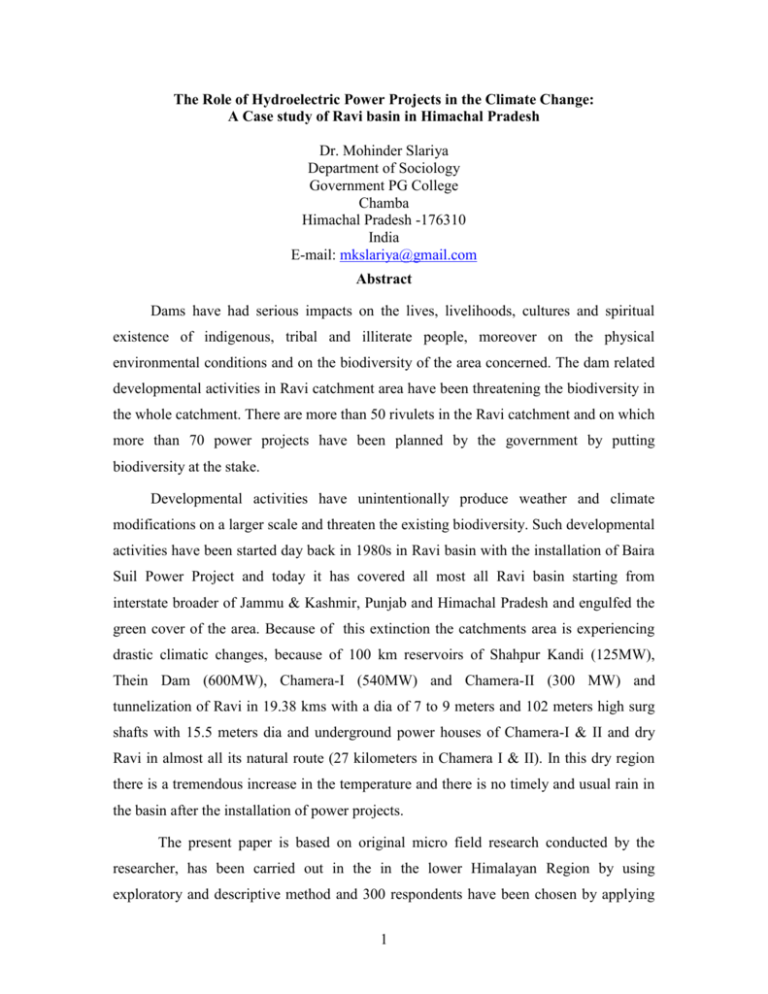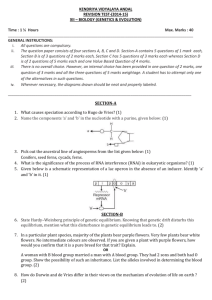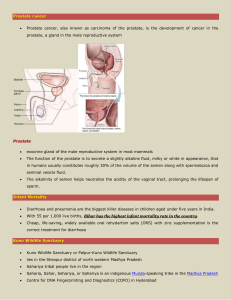the-role-of-hydroelectric-power-projects-in-the-climate-change
advertisement

The Role of Hydroelectric Power Projects in the Climate Change: A Case study of Ravi basin in Himachal Pradesh Dr. Mohinder Slariya Department of Sociology Government PG College Chamba Himachal Pradesh -176310 India E-mail: mkslariya@gmail.com Abstract Dams have had serious impacts on the lives, livelihoods, cultures and spiritual existence of indigenous, tribal and illiterate people, moreover on the physical environmental conditions and on the biodiversity of the area concerned. The dam related developmental activities in Ravi catchment area have been threatening the biodiversity in the whole catchment. There are more than 50 rivulets in the Ravi catchment and on which more than 70 power projects have been planned by the government by putting biodiversity at the stake. Developmental activities have unintentionally produce weather and climate modifications on a larger scale and threaten the existing biodiversity. Such developmental activities have been started day back in 1980s in Ravi basin with the installation of Baira Suil Power Project and today it has covered all most all Ravi basin starting from interstate broader of Jammu & Kashmir, Punjab and Himachal Pradesh and engulfed the green cover of the area. Because of this extinction the catchments area is experiencing drastic climatic changes, because of 100 km reservoirs of Shahpur Kandi (125MW), Thein Dam (600MW), Chamera-I (540MW) and Chamera-II (300 MW) and tunnelization of Ravi in 19.38 kms with a dia of 7 to 9 meters and 102 meters high surg shafts with 15.5 meters dia and underground power houses of Chamera-I & II and dry Ravi in almost all its natural route (27 kilometers in Chamera I & II). In this dry region there is a tremendous increase in the temperature and there is no timely and usual rain in the basin after the installation of power projects. The present paper is based on original micro field research conducted by the researcher, has been carried out in the in the lower Himalayan Region by using exploratory and descriptive method and 300 respondents have been chosen by applying 1 simple convenient and cluster sampling methods. To analyse the impacts on climatic conditions data provided by metrological department of executing agency and viewpoint of respondents have been recorded, analyzed and interpreted. Key Words: Dams; Climate change; Hydroelectric power projects; Environmental changes 2 The Role of Hydroelectric Power Projects in the Climate Change: A Case study of Ravi basin in Himachal Pradesh Dr. Mohinder Slariya* Introduction: Through out human history natural resources have been exploited to sustain growing human populations. Over the last few decades, rising economic growth rates in most developing countries have contributed to increasing levels of exploitation of natural resources and environment degradation, which unchecked could have detrimental effects on future growth patterns. Environmental degradation as a consequence of resource exploitation is a global phenomenon which is evident from the increasing levels of deforestation, polluted water, air and land resources. The Intergovernmental Panel on Climate Change (IPCC) projects that atmospheric carbon dioxide levels could reach 450-550 ppm by 2050. In the present developing state of country’s economy, there is a great requirement of electrical power for both industrial and agricultural use. The power requirement during March-April’03 for Northern Region was 156,610 MU (million units) against the availability of 144,218 MU. Thus, there was a deficit of 7.9%. As per the anticipated power supply position in 2006-07 (10th plan), this deficit will increase in future even after accounting the contribution of the upcoming power projects in the northern region. As per this report, in the year 2006-07, total energy and peak energy demands in the northern region shall be 220,820 MU and 355,540 MU against availability of 181,468 MU and 29,667 MU respectively. Thus, there shall be deficit of 17.8% and 16.5% for total energy and peak energy respectively, in the northern region. These deficit figures for all India are 12.9% and 12.3% respectively. Further, the Report of the Group on Power for 10th Plan estimated the need based capacity addition of 62,213 MW during 11th Plan. Thus, it is necessary to commission projects to generate power to bridge the ever-increasing gap in demand and supply scenario. To bridge up this gap Govt. of India has launched a massive plan known as “Mission2012, Power for All”, under which 50,000 MW hydroelectric power is to be added in the existing generation capacity. Out of estimated potential capacity of 1, 50,000 MW, only 15 per cent has been commissioned so far and 7 per cent is on the way of its commissioning. 3 The installations of power projects in the river basins have definitely a detrimental affects on the bio-diversity as well as on the climatic conditions of the area concerned. Moreover it has definitely a vital role to play to change the environmental conditions of the area concerned where such types of activities have been installed. Hydro electric Power Development in Himachal Pradesh: Himachal Pradesh is a mountainous state having about thousand perennial streams which form a diverse drainage system in the state. It has five perennial rivers of Indus water system i.e. Chenab, Yamuna, Ravi, Satluj and Beas. Out of these basins Beas, Satluj and Ravi basins contributes more than 72 % potential capacity out of 25000 MW assessed potential capacity of hydroelectric power generation in Himachal Pradesh. Power generation has got top priority from sixth five year plan i.e. 1980-85 onwards. During tenth five year plan i.e. 2002-2007 besides completing the ongoing projects as early as possible, the state government has prepared an ambitious plan to accelerate hydro power generation of identified potential capacity of 25,000 MW. Ravi has total catchment area of 5,451 sq. kilometers and 154 sq. km in Himachal Pradesh. This basin lies between the Pir Panjal and Dhauladhar ranges of lower Himalayas. The potential capacity of Ravi has been assessed 2301.5 MW; out of which 1038.5 MW has been commissioned so far through four commissioned power projects in Chamba district i.e. Baira suil (198 MW), Chamera-I (540 MW), Chamera-II (300 MW). In other words it can be stated that this basin has been heavily targeted for the hydroelectric power development since 1980s with the installation of NHPC’s first hydroelectric power generation plant with the name of Baira Suil Hydroelectric power project. After this power project Chamera series of projects have been started. In 1990s Chamera stage –I and in 2000s Chamera-II, and Chamera-III have contributed considerably and change the ecology and climatic conditions of the whole basin. Along with these, this basin has experienced a major jolt of development named as Thein Dam, which situated at the boarder of Himachal Pradesh, Punjab and Jammu and Kashmir. A number of power projects in Ravi basin either installed or proposed to be installed. The following table is presenting a clear picture of such of developmental activities in Ravi basin: 4 Table 1: Showing the Power Projects on Ravi basin: Sr. Name of Power Name of Classification Installation No. Project River/ nallah Capacity (in MW) 1. Chamera-I* Ravi Large 540.00 2. Chamera-II * Ravi Large 300.00 3. Chamera-III Ravi Large 231.00 4. Baira Suil * Baira Suil Large 198.00 5. Bhuri Singh * Saal Nala Micro 000.45 6. Tundah-I Tundah nallah Small 015.00 7. Tundah-II Tundah nallah Small 030.00 8. Bharmour Micro Budhil Micro 000.02 9. Garola Garola nallah Micro 000.05 10. Holi Holi nallah Small 003.00 11. Sal Stage –I Saal nallah Small 008.25 12. Sal Stage –II Saal nallah Small 002.25 13. Budhil Budhil nallah Medium 081.00 14 Bharmour Budhil nallah Medium 045.00 15. Harsar Budhil nallah Medium 060.00 16. Kugti Budhil nallah Medium 045.00 17. Kutehr Ravi Large 360.00 18. Sindi Ravi Medium 120.00 19. Bara Bangal Ravi Medium 160.00 20. Thein Dam Ravi & Sewa Large 600** *Indicates power projects in operation in Chamba district. **Thein dam (Maharaja Ranjeet Singh HE Power project with 600 MW Capacity at Shahpur Kandi near Pathankot (Punjab) situated at interstate boarder of Jammu & Kashmir, Himachal Pradesh and Punjab. The catchments area of Ravi basin is experiencing drastic climatic changes, because of 100 kilometers reservoirs of Shahpur Kandi (125 MW), Thein Dam (600 MW, with Catchment area of 6086 sq km & reservoir of 87 sq. km), Chamera-I (540 MW) and Chamera-II (300 MW); and tunnelization of Ravi in 19.38 kms with a dia of 7 to 9 meters and 102 meters high surg shafts with 15.5 meters dia and underground power houses of Chamera-I (89x22x42 meters) and Chamera-II and dry Ravi in almost all its natural route (27 kilometers in Chamera I and Chamera-II). And upcoming Chamera-III with a head race tunnel of 19.98 kms with 7 metres dia and which would led Ravi to be dried at a stretch of 35 kms, affecting the lives of thousands of people living in the down stream as well as of the flora and wild animal; broadly can be called as bio-diversity. 5 Table 2: Official data of Power Projects in Ravi basin in Chamba district of Himachal Pradesh: Item People Affected People Displaced Village affected Village Submerged Height of the dam Length of the Head Race Tunnel Length of Tail Race Tunnel Under ground power house Reservoir Forest affected area Trees affected (officially and increased manifold unofficially). Total area afforested (according to NHPC) Total trees planted by NHPC Money spent on plantation In Chamera-I 1554 families 1174 families 55 07 140 meters 6.4 km 2.45 km 74x71x82 meter 29 km 982.50 hectare 40,000 In Chamera-II 230 families 030 families 15 01 40 meter 7.83 km 3.46 km 100x22x39.5 meter 3.6 km 78.78 hectare 1380 2,000 hectare 172.58 hectare 39, 81,186 322.06 lakh 2,30,000 37 lakh Table 3: Present Status of Ravi in Himachal Pradesh: Ravi in Tunnel Ravi in reservoir Total area tunnel +reservoir Road distance from TRT Khairi to Bagga dam Ravi in its natural route 73-51.44 (Now left and occasionally seen) 19.38 KM 32.06 KM 51.44 KM 73.00KM 21.57 KM On the basis of above citation it can be stated that the installation of power projects in Ravi basin have affected the physical environment to a considerable extent. Large water body of 32.6 kilometer, underground blasts which had dried all vegetative cover and natural sources of water, above all tunnelization of Ravi (19.38 kilometer) are some area which are responsible to create the conditions for climate change. Authorities claiming the restoration of affected vegetation cover, by planting compensatory forest in the catchment area, but today not a single tree are visible. Because of which the dry portion of the catchment is experiencing extreme hot on the one hand and the vegetative 6 cover situated over the HRTs, TRTs, edits, underground power houses, shrug shafts is drying and dying on the other. Statement of Problem: During the data collection for the requirement of Ph.D. and UGC sponsored research projects a considerable affect on the climatic conditions has been felt by the researcher. By using observation method of research, the researcher has been told by the respondents in the study area that they are facing the problem of increased temperature, un usual rain, decrease in number of days of rain through out the year, which was unknown to them before the installation of power projects and these occurrences can be put in the category of climate change. The water in the reservoirs is not fresh and breeze which blown on the shores of Ravi is too hot in summer and too cold in winter, which has destabilize the climate cycle of the area. “Along with the dry area of Ravi because of these power projects, is responsible for the increase in the temperature in the area and Ravi is no where in its natural route”, enumerated by Sobhia Ram, one of the respondent met during data collection. The diverted water in the head race tunnel (HRTs) has left basin up to tail race tunnel (TRT) without water. The water has been released by the power producers at their will or when these mills produce electricity below tail race tunnels, but the distance between TRTs and HRTs remained dry throughout the year. Respondents in the study area have asserted that “this dryness has caused a lot climatic disorders in the Ravi basin and the power is being produced at the cost of the lives and livelihood of the people.” Methodology: To prove this it was decided by the researcher to investigate it, and for investigation prior and after climatic conditions of Chamba district have been studied and data on both conditions have been collected from the reliable sources, tabulated and interpreted by using simple statistic and used to draw scientific inferences. The data has been extracted from the published global CRU 2.1 dataset consisting of interpolated climate grids from the Tyndall Centre for Climate Change Research, Norwich, UK and researcher complied and interpreted the a according to the need of the paper. Results: To investigate the hypothetical conclusion drawn above, the installation of power projects in Ravi basin has considerably affect the climatic conditions of Chamba district of Himachal Pradesh, the data from 1986- 2002 has been analyzed. Data from 7 1986 to 1993 represents the prior conditions to the installation of power projects in Chamba and the data from 1994 to 2002 represents the conditions after the installation of power projects. Table 4: Showing Monthly average values in each year for Wet day frequency in Chamba district of Himachal Pradesh Prior to the installation of Power Projects [Period: From 1986 to 1993] [Units: Integer, days ] Month Year 1986 1987 1988 1989 1990 1991 1992 1993 Total Jan Feb Mar Apr May June July Aug Sept Oct Nov Dec Total 1.00 4.72 3.80 4.97 2.46 2.14 6.36 3.64 29.09 4.41 3.77 3.90 2.77 7.33 4.13 5.75 3.60 35.6 6 5.02 4.06 7.31 3.99 6.87 3.71 7.38 5.02 43.36 3.83 4.81 2.27 2.61 4.06 6.81 2.82 1.88 29.09 4.16 6.77 1.20 3.08 5.52 4.24 4.50 3.84 33.31 6.24 6.56 7.09 3.08 4.13 4.07 5.16 7.96 44.29 11.89 5.23 15.06 12.63 11.62 4.12 10.39 14.06 85.00 10.09 8.2 12.29 8.33 14.14 9.72 11.37 3.75 77.89 6.62 1.08 7.66 4.79 7.93 5.83 7.08 6.35 47.3 4 1.47 3.02 2.6 1.33 1.19 1.05 1.28 0.05 11.99 2.2 0.0 0.0 2.61 1.78 0.63 3.81 0.00 11.03 4.4 3.06 4.82 1.36 3.88 1.39 1.39 0.20 16.1 56.93 51.28 68.00 51.55 70.91 47.84 67.29 50.35 Source: Author’s compilation from Tyndall Centre for Climate Change Research, Norwich, UK and www.indiawaterportal.com Table 5: Showing Monthly average values in each year for Wet day frequency in Chamba district of Himachal Pradesh After the installation of Power Projects [Period: From 1994 to 2002] [Units: Integer, days ] Month Year 1994 1995 1996 1997 1998 1999 2000 2001 2002 Total Jan Feb Mar Apr May June July Aug Sept Oct Nov Dec Total 5.29 5.01 5.46 2.88 4.03 5.22 4.06 1.75 4.07 37.77 4.07 7.88 6.12 2.73 5.13 3.36 4.45 2.93 5.23 41.90 3.52 2.42 5.61 3.97 5.54 3.44 2.46 2.81 3.90 33.6 7 2.87 3.35 4.71 7.12 5.58 3.25 2.23 3.91 3.23 36.25 4.15 1.7 5.31 4.2 4.45 4.13 4.4 4.29 2.97 35.60 3.23 5.77 9.06 7.3 3.43 5.31 6.29 5.81 5.32 51.52 11.06 10.16 10.3 10.07 09.52 09.22 08.68 11.57 07.35 87.93 12.30 15.83 15.08 14.69 10.50 10.76 09.37 09.18 09.22 106.93 4.46 3.68 4.24 4.06 5.26 4.83 4.34 4.89 7.31 43.07 1.36 1.19 2.72 3.27 2.40 1.15 0.05 1.50 1.05 14.69 0.00 3.45 0.30 2.88 1.19 1.61 1.19 1.58 0.00 12.2 3.41 1.42 1.21 2.12 1.10 1.05 1.15 1.73 1.18 14.37 55.72 61.86 70.12 65.29 58.13 53.33 48.67 51.95 50.83 Source: Author’s compilation from Tyndall Centre for Climate Change Research, Norwich, UK and www.indiawaterportal.com As it is evident form the above tables: 5 and 6 which present an account of total wet days experienced in Chamba district of Himachal Pradesh, the condition prior to the installation of power project is differ from the conditions after the installation of power 8 projects. The data in the both variables is visible in the next table i.e. table 6 and 7 which enumerates month and year wise presentation of the data. Table 6: Comparative analysis of Monthly average values in each year for Wet day frequency in Chamba district of Himachal Pradesh Month Prior and after the installation of Power Projects [Period: From 1986 to 2002] [Units: Integer, days ] Before the installation of HEPs from After the installation of HEPs 1986-1993 from 1994-2002 Jan 29.09 37.77 Feb 35.66 41.90 Mar 43.36 33.67 Apr 29.09 36.25 May 33.31 35.60 Jun 44.29 51.52 Jul 85.00 87.93 Aug 77.89 106.93 Sep 47.34 43.07 Oct 11.99 14.69 Nov 11.03 12.2 Dec 16.1 14.37 464.20 515.90 Total Source: Author’s compilation from Tyndall Centre for Climate Change Research, Norwich, UK and www.indiawaterportal.com Table 6 highlights the comparative analysis of prior and after wet conditions (rainy days) of Chamba district and on the basis of table it can be stated that the whole district has faced or facing fluctuations in the climatic conditions. Number of wet days in January month before the installation of power projects was 29.9 and it increases to 37.77. All the months expect March, September and December have experienced upward increase Table 7: Comparative analysis of Monthly average values in each Year for Wet Day prior and after the installation of Power Projects in Chamba district of Himachal Pradesh from 1985 to 2002] [Units: Integer Days] Year 1985 1986 1987 1988 Wet Day Prior to the installation of Power Projects Not available 56.93 51.28 68.00 Year 1994 1995 1996 1997 9 Wet Day After the installation of Power Projects 55.72 61.86 70.12 65.29 1989 1990 1991 1992 1993 Total 51.55 70.91 47.84 67.29 50.35 1998 1999 2000 2001 2002 58.13 53.33 48.67 51.95 50.83 464.15 Total 515.90 Source: Author’s compilation from Tyndall Centre for Climate Change Research, Norwich, UK and www.indiawaterportal.com Table 7 presents a considerable difference in the monthly average value of the total wet days prior and after the installation power projects. Prior to the installation of power projects from 1986-1993 it was 464.15 days, which increases up to 515.90 days after the installation of power projects i.e. 1994-2002. Expect 1988.1990 and 1992 almost every year experienced upward increase in the wet day frequency. Table 8: Monthly average values in each year for Average Temperature Period: From 1985 to 1993 Units: Integer, Degree Celsius 1985 1986 1987 Prior to the installation of Power Projects 1988 1989 1990 1991 1992 1993 Total Jan 8.39 6.05 6.79 10.5 7.58 11.21 5.88 9.52 8.17 074.09 Feb 11.66 10.75 11.71 12.23 10.63 11.76 10.54 10.01 12.37 101.66 Mar 17.77 14.9 16.35 15.12 15.06 14.05 15.65 15 13.58 137.48 Apr 22.32 20.7 21.58 22.87 19.89 20.57 19.73 20.78 21.43 189.87 May 26 23.78 22.61 26.75 24.97 26.81 24.95 24.27 26.12 226.26 Jun 28.21 27.44 27.13 27.79 26.87 29.39 27.55 27.41 28.01 249.80 Jul 26.73 26.2 27.5 27.09 26.26 26.75 27.52 26.1 26.1 240.25 Aug 26.45 25.87 26.79 25.74 24.54 26.04 25.97 25.85 26.45 233.70 Sep 25.02 24.21 25.59 24.63 24.27 24.84 24.61 23.96 24.51 221.64 Oct 20.29 20.24 20.77 20.04 20.43 20.09 19.71 20.56 20.41 182.54 Nov 14.01 15.19 15.1 15.13 14.39 13.9 14.06 14.86 15.66 132.30 Dec 10.89 8.31 10.12 10.45 10.25 9.85 10.68 11.41 10.42 092.38 Total 237.74 223.64 232.04 238.34 225.14 235.26 226.85 229.73 233.23 Year Month Source: Author’s compilation from Tyndall Centre for Climate Change Research, Norwich, UK and www.indiawaterportal.com Table 9: Monthly Average values in each year for Average Temperature Period: From 1994 to 2002 Units: Integer, Degree Celsius After the installation of Power Projects Year 1994 1995 1996 1997 1998 10 1999 2000 2001 2002 Total Month Jan 9.65 6.5 8.65 9.15 6.75 8.42 9.69 9.88 9.83 078.52 Feb 10.48 10.01 12.33 11.07 11.71 13.55 9.7 12.05 11.22 102.12 Mar 17.28 14.95 16.44 15.67 14.16 17.03 15.32 16.89 16.92 144.66 Apr 19.55 20.17 21.82 21.14 21.7 24.97 23.24 21.71 22.3 196.60 May 25.93 26.87 24.39 24.15 26.41 26.5 27.66 27.37 27.22 236.50 Jun 28.97 29.41 27.15 26.71 28.66 27.3 27.39 27 28.41 251.00 Jul 27.72 26.55 26.25 27.8 27.56 28.13 27.22 27.86 27.87 246.96 Aug 26.47 25.57 24.36 25.58 26.69 26.69 26.38 26.98 26.88 235.60 Sep 24.14 24.02 24.74 25.34 25.5 26.03 25.42 24.86 23.17 223.22 Oct 20.02 20.81 19.98 19.37 21.65 21.63 22.42 22.22 21.71 189.81 Nov 15.08 14.92 14.08 14.32 14.29 16.2 16.77 15.89 16.53 138.08 Dec 10.41 10.27 8.99 9.7 10.26 11.16 11.78 11.48 10.64 094.69 Total 235.7 230.05 229.18 242.99 244.19 242.7 230 235.34 247.61 Source: Author’s compilation from Tyndall Centre for Climate Change Research, Norwich, UK and www.indiawaterportal.com Table 8 and 9 enumerates the monthly average temperature before and after the installation of power projects. The comparative analysis of the data is visible in the following table i.e. table 10 and 11. Table 10: Monthly Average values in each year for Average temperature Period: From 1985 to 2002 Units: Integer, degree Celsius Month Before the installation of HEPs from 1985-1993 After the installation of HEPs from 1994-2002 Jan 074.09 078.52 Feb 101.66 102.12 Mar 137.48 144.66 Apr 189.87 196.60 May 226.26 236.50 Jun 249.80 251.00 Jul 240.25 246.96 Aug 233.70 235.60 Sep 221.64 223.22 Oct 182.54 189.81 Nov 132.30 138.08 Dec 092.38 094.69 Total 2081.97 2137.76 11 Source: Author’s compilation from Tyndall Centre for Climate Change Research, Norwich, UK and www.indiawaterportal.com Month wise data of the temperature (table:10) shows that total temperature of the Chamba district has increased form 2081.97 degree Celsius to 2137.76 degree Celsius after the installation of power projects. Every month from January to December has experienced upward increase in the temperature in Chamba district of Himachal Pradesh. Table 11: Monthly average values in each year for Average Temperature [Period: From 1985 to 2002] [Units: Integer degree Celsius] Prior to the installation of Power Projects Year 1985 1986 1987 1988 1989 1990 1991 1992 1993 Total After the installation of Power Projects Average Temperature 237.74 223.64 232.04 238.34 225.14 235.26 226.85 229.73 233.23 Year 1994 1995 1996 1997 1998 1999 2000 2001 2002 Average Temperature 235.70 230.05 229.18 230.00 235.34 247.61 242.99 244.19 242.70 2081.97 Total 2137.76 Source: Author’s compilation from Tyndall Centre for Climate Change Research, Norwich, UK and www.indiawaterportal.com Average temperature from the period 1985 to 2002 as shown in table: 11 shows that every year staring from 1985 to 2002 has experienced upward increase to a considerable extent. The data of nine years prior to the installation of power projects is fluctuated in nature. It receive fluctuation in every year whereas after the installation of power projects average temperature has increased and from 1994 to 2002 it is fluctuating in one month and the other month it has changed. Discussions: As it is evident form the above tables (tables 1-3) that power projects in Ravi basin in Chamba district of Himachal Pradesh has given jolts to the physical environment by creating reservoirs, tunnels, edits, widening and construction work, which led the catchment area to get dried and the perennial Ravi is now seen either in reservoirs or in tunnels. 154 kms long Ravi river is producing 1830 MW power and 45 other projects of different magnitudes in this basin are in different stage of their execution. This much disturbance has created a considerable affect on the climatic conditions of the whole 12 district. The people who are living in the vicinity of these power projects are paying the cost, while some by living in meteors cities are enjoying its fruits. Because of these climatic changes people are facing all sort of ill effects like decrease in crop production, water mills are getting dried, static water of reservoirs is helping to create health hazards and spreading water born diseases, sources of livelihood have been snatched etc. and the life of the people have become worse because of these power projects. It may be better for the people who are living far away and enjoying the electricity but their concerns are unlistened even after the 15 years of Chamera-I execution and 46 years of commissioning of two mega projects of Himachal Pradesh i.e. Bhakra and Pong dams. The affected people of these two projects are still waiting for the justice and the people who remained there and living in the vicinity of reservoirs of these projects are facing the problem of climate change. In short it can be asserted on the basis of above citations that not only the affected people in revenue record but all the residents who are living in the Ravi basin in Chamba district are facing the ill affects of these power projects in form of changes in the climatic conditions. People of the whole basin have never experienced the problems of increase in temperature or unusual and unseasonal rain before the installation of power projects but after the installation of power project (after 1994) it became a routine phenomena. Conclusion: The Ravi basin is being harnessed very badly from Madhopur to Bharmour (table; 1). Now, the policy makers of state as well as national level must think judiciously before granting permission to install any such type of hydroelectric power projects. The researcher is not against the installation of power projects but these must be ecofriendly and sustainable in nature and there must be sustainable and considerable improvement in human welfare. This means a significant advancement of human development, which is economically viable, socially equitable and environmentally sustainable. If the dams are the best way to achieve this goal, then deserve the full support of the researcher. The local issues must be taken into consideration properly and with true spirit, not in paper and must not be engulfed by the red tapism. The policies should be framed by visiting local sites and taking local issues into consideration. Before sanctioning any other power project for Ravi basin the World 13 Commission on Dams recommendations must be taken into consideration, which has stressed four fundamental values regarding the dam building, these are; equity, efficiency, participatory decision-making, sustainability and accountability. We all the travelers of one spaceship earth, any trespass even in the name of development may have detrimental effect. The affect of such types of developmental initiatives on climate and climatic conditions may put a question mark on the availability of water and glaciers because the permission to install power projects from Bara Bhangal glacier from where Ravi originates to Madhopur, from where it enters in Pakistan there are 45 projects, 09 commissioned and remaining 36 are yet to be commissioned. It is the impact of these nine commissioned projects in Ravi basin in three states i.e. Himachal Pradesh, Punjab and Jammu and Kashmir which has been given in the above tables. One thing must be kept in mind that everything can be generated but water cannot. Once it is lost it will be lost forever, it cannot be generated. So the need of the hour is to use this wonderful gift of god to meet our need not to greed. We must keep ourselves away from the natural cycle of the water and should not disturb it in the name of so called development because Nature can live without man but man cannot. Data used in this paper is based on the research projects completed/ongoing by the author: Slariya, Mohinder (1995), “Industrialization and Environment- A Case Study of ACC Cement Factory in Bilaspur district of Himachal Pradesh.” Unpublished Project Report; submitted to the Department of Sociology, Himachal Pradesh University, Shimla; India. Slariya, Mohinder (2006), “Ecology of Power Projects- An Environmental Study of Hydroelectric Power Projects in Ravi basin.” Unpublished Minor Research Project; submitted to University Grants Commission, New Delhi, India. Slariya, Mohinder (2007), “A Study of Impacts of Hydroelectric Power Projects on Ecology and Society in Chamba District of Himachal Pradesh.” Ph.D. thesis submitted to MJP Rohilkhand University, Bareilly; Uttar Pradesh; India. Slariya, Mohinder (2008), “Displacement- A Psychological Trauma: An Environmental Study of Displace People of Chamera-I.” ongoing Minor Research Project; sponsored by University Grants Commission, New Delhi, India. 14 Bibliography: Census of India (2001). Himachal Pradesh Series-3, New Delhi: Govt. of India. Council of Power Utilities in India (2000). New Delhi: Govt. of India. Economic Survey of Himachal Pradesh (2003-04). Shimla: Department of Economics & Statistics, Govt. of H.P. Global Possible Conference (1984); The Global Possible: Resources, Development, & the New Century, Washington: World Resources Institute. Harnot,S.R. & Verma, R.P. (2004). Himachal At a Glance,Shimla: Minerva Book House. Land Acquisition Act (1984). New Delhi: Government of India. Nehru, J.L. (1958). Modern Temples of India, Selected Speeches of Nehru, New Delhi: Ministry of Information and Broadcasting, Govt. of India. Odum, E.P. (1996). Fundamentals of Ecology, Dehradun: Natraj Publications. Ojha, N.N. (2005). Ecology and Environment, New Delhi: Chronicle Publications Pvt. Ltd. Prasad, Y. (2000). Conventional Source of Energy - Need for Sustained Emphasis on Hydro Electric Development, Water Power, Vol.2, No.8, June 2000, Faridabad: NHPC. Robinson, H. (1981). Population and Resources, New Delhi: The Macmillan Publications Pvt. Ltd. Roy, A. (1999). The Greater Common Good, Bombay: India Book Distributors Ltd. Schmoelling, J. (2003). Management of integrated Pollution control- Concerning Air, Water Pollution Waste Management, in S.P. Dasgupta (ed) Environmental Issues of 21st Century, New Delhi: Mittal Publications. The Report of the Group on Power for 10th Five Year Plan and projections for 11th Five year Plan; New Delhi, Government of India Tyndall Centre for Climate Change Research, Norwich, UK www.nhpcindia.org www.waterportalindia.org www.planningcommission.gov.in www.wcd.org www.irn.org Zimmerman (1980) Population Geography, London: The Macmillan Press. 15





